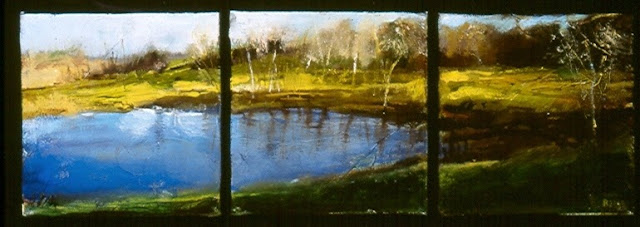Here are some things I have learned in my many years of painting, which might be helpful to some of you out there who are trying to create oil paintings. Or good reminders for you established painters. In fact, send me YOUR hints and I will add them to the list. These are things that I have learned from others, and/ or just learned by doing.
1. Be disciplined, and paint as often as you can. When you stop for too long, it is as if you have to reinvent the wheel, and start learning all over again -- at least for a little while, and then it comes back BUT NOT SO EASILY. Like anything else, you have to PRACTICE -- the more you paint the better you become.
2. You can paint the same thing over and over, and learn something each time. Artists often do studies of paintings before embarking on the “big one.” I do not have the patience for that, but I do sometimes paint the same subject more than once, almost like practicing. I find the second time around I begin to internalize the subject, the values, the refinement of the composition. I have painted the view from my windows over and over, and each time it is different.
 |
| In Just Spring oil on canvas with tissue underlay |
 |
| Glimpse of Glory oil on clayboard |
The triptych above, three 8" x 8" blocks, and the next painting are just two examples of paintings I have done of the view from the house. The triptych is the image I used for a show postcard some years back. Both of these pieces sold at different galleries.
3. Get away from your work--- move back and view it from a distance as often as possible. That’s why it is better to stand than sit to paint, but with some stenosis problems, I cannot do that too often. Turn your piece upside down at look at it, viewing the masses, the colors, the shapes, hues and values instead of the subject matter. Squint and get a hazy, value-blocked-in view.
As a corollary, look at the big picture, and try to stay clear of minutia, tiny details, which really do not matter that much, unless it is the final highlights that can really pop the painting. I find that by standing back and painting, I free myself, and use my arm and eye rather than my hands and fingers to paint. Another thing that has freed my eye is to paint triptychs--- somehow the idea of one panel flowing into another, without the confinement of edges, is very liberating.
 |
| October Silence oil on canvas |
Above is asmall triptych, three 4" x 4" blocks. It was in the show at Skidmore's Tang Museum and featured in the college on line newsletter with my website selected by an art faculty member as website of the month. I was very pleased! It is currently in the Gilded Edge Gallery in Hanover, NH. In any case, an example the freedom that this form allows me.
4. Never ever underestimate the power of composition in a painting. . No matter how well a piece is painted, without a good composition it will fail.
5. Keep two or three paintings going at once, so that one can be drying as another one is being worked. When working on a number of paintings at the same time, they may be painted simultaneously but they are frequently dissimilar, taking off in completely different directions. It keeps the mind active!
6. Every now and then, try to get out of your vacuum. Artists work alone, and often lack the input and valuable give and take that is so important to their work. Gather a few artist friends and get together and critique each other’s work, or hire an art professor to come in and do it for a small group. Bring in your problematic pieces, and let him or her have at them. Another good idea is to create an art blog such as this one and post your work, and ask for feedback.



Those are indeed Useful Rules To Paint By.
ReplyDeleteI'd add: stop thinking about painting something and actually do it. I go for years thinking of things I'd paint, "if only I had the time." Well, time is running out.
With regard to stepping back and looking at a thing, squinting at it, etc., I'd opine that it helps to hold a preliminary pencil sketch up to a window and look at it through the paper, backwards -- all sorts of odd shapes and wacked perspective leap out glaringly clear.
From my artist friend Laura Young: Tips on painting: I don't have any! It seems like your ptgs. are doing what you want them to be doing. Technique and materials have to serve the message, whatever it is. Not the other way around. Anyway, that's what I've discovered over time.
ReplyDeleteHi Debbie,
ReplyDeleteI am an assemblage artist and "folk" painter, and find having two three projects going on at once a great benefit. It seems that when I am working on a project either I reach a point were i need to stop and maybe revisit it again tomorrow or something needs to dry and my juices are still flowing and I can turn to another project laying in wait. One of the interesting things that I have found out is that between an assemblage art work and a painted one there is a thread that ties them together, if they are being created around the same time.
Myra